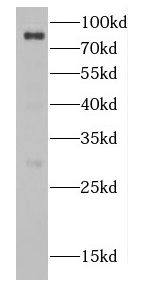Products
CBFA2T2 antibody
| Synonyms: | Protein CBFA2T2|ETO homologous on chromosome 20|MTG8-like protein|MTG8-related protein 1|Myeloid translocation-related protein 1|p85|CBFA2T2|EHT|MTGR1 antibody | ||
| Catalogue No.: | FNab01315 | Reactivity: | Human, Mouse, Rat |
| Host: | Rabbit | Tested Application: | ELISA, WB, IHC |
| Clonality: | polyclonal | Isotype: | IgG |
| Size | Price |
|---|---|
| 100µg | Inquiry |
- SPECIFICATIONS
- FIGURES
- CONDITIONS
- FAQS
- Product Name
- CBFA2T2 antibody
- Catalogue No.
- FNab01315
- Size
- 100μg
- Form
- liquid
- Purification
- Immunogen affinity purified
- Purity
- ≥95% as determined by SDS-PAGE
- Clonality
- polyclonal
- Isotype
- IgG
- Storage
- PBS with 0.02% sodium azide and 50% glycerol pH 7.3, -20℃ for 12 months(Avoid repeated freeze / thaw cycles.)
- Immunogen
- core-binding factor, runt domain, alpha subunit 2; translocated to, 2
- Alternative Names
- Protein CBFA2T2|ETO homologous on chromosome 20|MTG8-like protein|MTG8-related protein 1|Myeloid translocation-related protein 1|p85|CBFA2T2|EHT|MTGR1 antibody
- UniProt ID
- O43439
- Observed MW
- 85 kDa
- Tested Applications
- ELISA, WB, IHC
- Recommended dilution
- WB: 1:500-1:2000; IHC: 1:20-1:200
 HEK-293 cells were subjected to SDS PAGE followed by western blot with FNab01315(CBFA2T2 antibody) at dilution of 1:300
HEK-293 cells were subjected to SDS PAGE followed by western blot with FNab01315(CBFA2T2 antibody) at dilution of 1:300
 Immunohistochemistry of paraffin-embedded human gliomas using FNab01315(CBFA2T2 antibody) at dilution of 1:50
Immunohistochemistry of paraffin-embedded human gliomas using FNab01315(CBFA2T2 antibody) at dilution of 1:50
- Background
- Transcriptional corepressor which facilitates transcriptional repression via its association with DNA-binding transcription factors and recruitment of other corepressors and histone-modifying enzymes(PubMed:12559562, PubMed:15203199). Via association with PRDM14 is involved in regulation of embryonic stem cell(ESC) pluripotency(PubMed:27281218). Involved in primordial germ cell(PCG) formation. Stabilizes PRDM14 and OCT4 on chromatin in a homooligomerization-dependent manner(By similarity). Can repress the expression of MMP7 in a ZBTB33-dependent manner(PubMed:23251453). May function as a complex with the chimeric protein RUNX1/AML1-CBFA2T1/MTG8(AML1-MTG8/ETO fusion protein) which is produced in acute myeloid leukemia with the chromosomal translocation t(8;21). May thus be involved in the repression of AML1-dependent transcription and the induction of G-CSF/CSF3-dependent cell growth. May be a tumor suppressor gene candidate involved in myeloid tumors with the deletion of the 20q11 region. Through heteromerization with CBFA2T3/MTG16 may be involved in regulation of the proliferation and the differentiation of erythroid progenitors by repressing the expression of TAL1 target genes(By similarity). Required for the maintenance of the secretory cell lineage in the small intestine. Can inhibit Notch signaling probably by association with RBPJ and may be involved in GFI1-mediated Paneth cell differentiation(By similarity).
How many times can antibodies be recycled?
First, usually it's not suggested to recycle antibodies. After use, buffer system of antibodies has changed. The storage condition of recycled antibodies for different customers also varies. Thus, the performance efficiency of recycled antibodies can’t be guaranteed. Besides, FineTest ever conducted the antibody recycling assay. Assay results show recycling times of different antibodies also varies. Usually, higher antibody titer allows more repeated use. Customers can determine based on experimental requirements.
Notes: After incubation, we recycle rest antibodies to centrifuge tube and store at 4℃. High titer antibodies can be stored for a minimum of one week. Reuse about three times.
What are components of FineTest antibody buffer?
Components of FineTest antibody buffer are usually PBS with proclin300 or sodium azide, BSA, 50% glycerol. Common preservative is proclin300 or sodium azide, which is widely applied in the lab and industry.
How about the storage temperature and duration of FineTest antibodies?
Most antibodies are stored at -20℃. Directly-labeled flow cytometry antibodies should be stored at 2 - 8℃. The shelf life is one year. If after sales issues for purchased antibodies appear, return or replacement is available. Usually, antibodies can be still used after the one-year warranty. We can offer technical support services.
Is dilution required for FineTest antibodies? What’s the dilute solution?
Directly-labeled flow cytometry antibodies are ready-to-use without dilution. Other antibodies are usually concentrated. Follow the dilution ratio suggested in the manual. Dilute solution for different experiments also varies. Common antibody dilution buffers are acceptable(e.g. PBST, TBST, antibody blocking buffer).
How to retrieve antibodies for immunohistochemistry?
Common retrieval buffers: Tris-EDTA Buffer(pH 9.0); Citrate Buffer(pH 6.0)
Heat induced antibody retrieval:
Method 1: Water-bath heating: Put the beaker with retrieval buffer and slide in the boiling water bath. Keep the boiling state for 15min. Naturally cool to room temperature;
Method 2: Microwave retrieval: Put the beaker with retrieval buffer and slide in the microwave oven. Heat at high power for 5min, Switch OFF for 3min, Heat at medium power for 5min. Naturally cool to room temperature.
How to choose secondary antibodies?
(1) Secondary antibodies react with primary antibodies. Thus, secondary antibodies should be against host species of primary antibodies. E.g. If the primary antibody is derived from rabbit, the relevant secondary antibody should be against rabbit. E.g. goat anti rabbit or donkey anti rabbit.
(2) Choose secondary antibody conjugates according to the experimental type, e.g. ELISA, WB, IHC etc. Common enzyme conjugated secondary antibodies are labelled by HRP, AP etc. Fluorescin or dye labelled secondary antibodies are applied in immunofluorescence and flow cytometry(e.g. FITC, Cy3).
